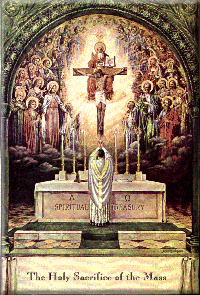
Home
Conference News
Favorite Links
Saint of the Month
Inspiration from the Saints
|
 |
|
Saint of the Month
Blessed Be God
In His Angels and His Saints
|
 Blessed are Thee, Lord God of Hosts!
Blessed are Thee, Lord God of Hosts!
|
|
Blessed Be Saint Cecilia
There have been problems with the historical facts surrounding St. Cecilia.
First: "Cecilia, though wedded, according to Roman law, to a nobleman by the name of Valerian, is always listed as a virgin, as well as a martyr, because her husband respected her private vow to become the bride of Christ and never exercised his marital rights" (Keyes).
Second: The Latin of first words of antiphon at Lauds on her feast day are `cantantibus organis,' so since the 16th century she is depicted as playing an organ and is the patron of church music and musicians. But it means music made in her heart to God at her wedding to Valerian, not that she herself played her own wedding music on the organ. The image is particularly anachronistic because she would not be playing the pipe organ with which we are familiar but an instrument similar to a calliope, which the early Christians would have associated with the Roman circus and spectacles. Therefore, she would have been more likely to trample such an instrument underfoot than to play it.
|
|
Third: She is commonly listed as a martyr, but there is no evidence of her martyrdom in Rome.
Cecilia is not mentioned in the early Deposito Martyrum of the 4th century, nor any of the early saints who were especially interested in the martyrs (e.g., Saints Ambrose, Jerome, Damasus, and Prudentius). The first mentioned of her name comes about the year 545 when the Passion of Saint Cecilia was written. The author of her Life may be an African refugee who came to Rome c. 488. He uses the argumentation of Augustine and Tertullian that Saint Valerian and his brother Saint Tiburtius were real martyrs, but Saint Cecilia is unconnected to them.
Even the date of her death is uncertain--estimated at anywhere between 177 to the fourth century, though the martyrdom of her supposed husband (according to the Roman Martyrology) was under Emperor Alexander, who ruled 222-35.
It is more likely that Saint Cecilia was the founder of parish church of that name in the Trastevere section of Rome. Founders of churches were often later turned into saints, not just in Rome. See Vie des Saints by the monks of Abbaye Sainte-Marie for further details on this aspect.
Her name, that she founded a church, and that she was buried in the cemetery of Saint Callixtus (donated to the Church by Cecilia) is all that is really known about Saint Cecilia. Her tomb in the cemetery was the prominent feature of a crypt adjoining the papal crypt according to inscriptions found there.
|
|
|
|